This is “Population”, section 14.2 from the book Sociology: Brief Edition (v. 1.0). For details on it (including licensing), click here.
For more information on the source of this book, or why it is available for free, please see the project's home page. You can browse or download additional books there. To download a .zip file containing this book to use offline, simply click here.
14.2 Population
Learning Objectives
- Explain why there is less concern about population growth now than there was a generation ago.
- Describe how demographers measure birth and death rates.
- Understand demographic transition theory and how it compares with the views of Malthus.
We have commented that population growth is an important source of other changes in society. A generation ago, population growth was a major issue in the United States and some other nations. Zero population growth, or ZPG, was a slogan often heard. There was much concern over the rapidly growing population in the United States and, especially, around the world, and there was fear that our “small planet” could not support massive increases in the number of people (Ehrlich, 1969).Ehrlich, P. R. (1969). The population bomb. San Francisco, CA: Sierra Club. Some of the most dire predictions of the time warned of serious food shortages by the end of the century.
Those predictions did not come to pass, and concern over population growth has faded as the world’s resources seem to be standing up to population growth. Widespread hunger in Africa and other regions does exist, with hundreds of millions of people suffering from hunger and malnutrition, but many experts attribute this problem not to overpopulation and lack of food but rather to problems in distributing the sufficient amount of food that actually does exist to people in poor nations (see “Sociology Making a Difference” box).
Sociology Making a Difference
World Hunger and the Scarcity Fallacy
A popular belief is that world hunger exists because there is too little food to feed too many people in poor nations in Africa, Asia, and elsewhere. Sociologists Stephen J. Scanlan, J. Craig Jenkins, and Lindsey Peterson (2010)Scanlan, S. J., Jenkins, J. C., & Peterson, L. (2010). The scarcity fallacy. Contexts, 9(1), 34–39. call this belief the “scarcity fallacy.” According to these authors, “The conventional wisdom is that world hunger exists primarily because of natural disasters, population pressure, and shortfalls in food production” (p. 35). However, this conventional wisdom is mistaken, as world hunger stems not from a shortage of food but from the inability to deliver what is actually a sufficient amount of food to the world’s poor. As Scanlan and colleagues note,
A good deal of thinking and research in sociology suggests that world hunger has less to do with the shortage of food than with a shortage of affordable or accessible food. Sociologists have found that social inequalities, distribution systems, and other economic and political factors create barriers to food access. (p. 35)
This sociological view has important implications for how the world should try to reduce global hunger, say these authors. International organizations such as the World Bank and several United Nations agencies have long believed that hunger is due to food scarcity, and this belief underlies the typical approaches to reducing world hunger that focus on increasing food supplies with new technologies and developing more efficient methods of delivering food. But if food scarcity is not a problem, then other approaches are necessary.
Scanlan and colleagues argue that food scarcity is, in fact, not the problem that international agencies and most people believe it to be:
The bigger problem with emphasizing food supply as the problem, however, is that scarcity is largely a myth. On a per capita basis, food is more plentiful today than any other time in human history.…[E]ven in times of localized production shortfalls or regional famines there has long been a global food surplus. (p. 35)
If the problem is not a lack of food, then what is the problem? Scanlan and colleagues argue that the real problem is a lack of access to food and a lack of equitable distribution of food: “Rather than food scarcity, then, we should focus our attention on the persistent inequalities that often accompany the growth in food supply” (p. 36).
What are these inequalities? Recognizing that hunger is especially concentrated in the poorest nations, the authors note that these nations lack the funds to import the abundant food that does exist. These nations’ poverty, then, is one inequality that leads to world hunger, but gender and ethnic inequalities are also responsible. For example, women around the world are more likely than men to suffer from hunger, and hunger is more common in nations with greater rates of gender inequality (as measured by gender differences in education and income, among other criteria). Hunger is also more common among ethnic minorities not only in poor nations but also in wealthier nations. In findings from their own research, these sociologists add, hunger lessens when nations democratize, when political rights are protected, and when gender and ethnic inequality is reduced.
If inequality underlies world hunger, they add, then efforts to reduce world hunger will succeed only to the extent that they recognize the importance of inequality in this regard: “To get at inequality, policy must give attention to democratic governance and human rights, fixing the politics of food aid, and tending to the challenges posed by the global economy” (p. 38). For this to happen, they say, food must be upheld as a “fundamental human right.” More generally, world hunger cannot be effectively reduced unless and until ethnic and gender inequality is reduced. Scanlan and colleagues conclude,
The challenge, in short, is to create a more equitable and just society in which food access is ensured for all. Food scarcity matters. However, it is rooted in social conditions and institutional dynamics that must be the focus of any policy innovations that might make a real difference. (p. 39)
In calling attention to the myth of food scarcity and the inequalities that contribute to world hunger, Scanlan and colleagues point to better strategies for addressing this significant international problem. Once again, sociology is making a difference.
Concern over population growth also decreased because of criticism by people of color that ZPG was directed largely at their ranks and smacked of racism. The call for population control, they said, was a disguised call for controlling the growth of their own populations and thus reducing their influence (Kuumba, 1993).Kuumba, M. B. (1993). Perpetuating neo-colonialism through population control: South Africa and the United States. Africa Today, 40(3), 79–85.
Still another reason for the reduced concern over population growth is that birth rates in many industrial nations have slowed considerably. Some nations are even experiencing population declines, while several more are projected to have population declines by 2050 (Goldstein, Sobotka, & Jasilioniene, 2009).Goldstein, J. R., Sobotka, T., & Jasilioniene, A. (2009). The end of “lowest-low” fertility? Population & Development Review, 35(4), 663–699. doi:10.1111/j.1728–4457.2009.00304.x For a country to maintain its population, the average woman needs to have 2.1 children, the replacement level for population stability. But several industrial nations, not including the United States, are far below this level. Increased birth control is one reason for their lower fertility rates, but so are the decisions by women to stay in school longer and then to go to work right after their schooling ends and not having their first child until somewhat later.
Figure 14.4

Spain is one of several European nations that have been experiencing a population decline because of lower birth rates. Like some other nations, Spain has adopted pronatalist policies to encourage people to have more children; it provides 2,500 euros, about $3,400, for each child.
Source: Photo courtesy of Sergi Larripa, http://commons.wikimedia.org/wiki/File:BCN01.JPG.
Ironically, these nations’ population declines have begun to concern demographers and policy makers (Shorto, 2008).Shorto, R. (2008, June 2). No babies? The New York Times Magazine. Retrieved from http://www.nytimes.com/2008/06/29/magazine/29Birth-t.html?scp=1&sq=&st=nyt Because people in many industrial nations are living longer while the birth rate drops, these nations are increasingly having a greater proportion of older people and a smaller proportion of younger people. In several European nations, there are more people 61 or older than 19 or younger. As this trend continues, it will become increasingly difficult to take care of the health and income needs of so many older persons, and there may be too few younger people to fill the many jobs and provide the many services that an industrial society demands. The smaller labor force may also mean that governments will have fewer income tax dollars to provide these services.
To deal with these problems, several governments have initiated pronatalist policies aimed at encouraging women to have more children. In particular, they provide generous child-care subsidies, tax incentives, and flexible work schedules designed to make it easier to bear and raise children, and some even provide couples outright cash payments when they have an additional child. Russia in some cases provides the equivalent of about $9,000 for each child beyond the first, while Spain provides 2,500 euros (equivalent to about $3,400) for each child (Haub, 2009).Haub, C. (2009). Birth rates rising in some low birth-rate countries. Washington, DC: Population Reference Bureau. Retrieved from http://www.prb.org/Articles/2009/fallingbirthrates.aspx
Demography and Demographic Concepts
As all of these issues indicate, changes in the size and composition of population have important implications for other social changes. The study of population is so significant that it occupies a special subfield within sociology called demographyThe study of population growth and changes in population composition.. To be more precise, demography is the study of changes in the size and composition of population. It encompasses several concepts: fertility and birth rates, mortality and death rates, and migration (Weeks, 2008).Weeks, J. R. (2008). Population: An introduction to concepts and issues (10th ed.). Belmont, CA: Wadsworth. Let’s look at each of these briefly.
Fertility and Birth Rates
FertilityThe number of live births. refers to the number of live births. Demographers use several measures of fertility. One measure is the crude birth rateThe number of live births for every 1,000 people in a population in a given year., or the number of live births for every 1,000 people in a population in a given year. To determine the crude birth rate, the number of live births in a year is divided by the population size, and this result is then multiplied by 1,000. For example, in 2008 the United States had a population of about 304 million and 4,251,095 births. Dividing the latter figure by the former figure gives us 0.0140 rounded off. We then multiply this quotient by 1,000 to yield a crude birth rate of 14.0 births per 1,000 population (U.S. Census Bureau, 2010).U.S. Census Bureau. (2010). Statistical abstract of the United States: 2010. Washington, DC: U.S. Government Printing Office. Retrieved from http://www.census.gov/compendia/statab We call this a “crude” birth rate because the denominator, population size, consists of the total population, not just the number of women or even the number of women of childbearing age (commonly considered 15–44).
A second measure is the general fertility rateThe number of live births per 1,000 women aged 15–44. (also just called the fertility rate or birth rate), or the number of live births per 1,000 women aged 15–44 (i.e., of childbearing age). This is calculated in a manner similar to that for the crude fertility rate, but in this case the number of births is divided by the number of women aged 15–44 before multiplying by 1,000. The U.S. general fertility rate for 2007 was about 69.5 (i.e., 69.5 births per 1,000 women aged 15–44) (Hamilton, Martin, & Ventura, 2009).Hamilton, B. E., Martin, J. A., & Ventura, S. J. (2009). Births: Preliminary data for 2007. National Vital Statistics Reports, 57(12), 1–12.
A third measure is the total fertility rateThe number of children an average woman is expected to have in her lifetime, sometimes expressed as the number of children an average 1,000 women are expected to have in their lifetimes., or the number of children an average woman is expected to have in her lifetime. This measure often appears in the news media and is more easily understood by the public than either of the first two measures. In 2007, the U.S. total fertility rate was 2.1. Sometimes the total fertility rate is expressed as the average number of births that an average group of 1,000 women would be expected to have. In this case, the average number of children that one woman is expected to have is simply multiplied by 1,000. Using this latter calculation, the U.S. total fertility rate in 2007 was 2,100 (i.e., an average group of 1,000 women would be expected to have, in their lifetimes, 2,100 children) (Hamilton et al., 2009).Hamilton, B. E., Martin, J. A., & Ventura, S. J. (2009). Births: Preliminary data for 2007. National Vital Statistics Reports, 57(12), 1–12.
As Figure 14.5 "U.S. General Fertility Rate, 1920–2005" indicates, the U.S. general fertility rate has changed a lot since 1920, dropping from 101 (per 1,000 women aged 15–44) in 1920 to 70 in 1935, during the Great Depression, before rising afterward until 1955. (Note the very sharp increase from 1945 to 1955, as the post–World War II baby boom began.) The fertility rate then fell steadily after 1960 until the 1970s but has remained rather steady since then, fluctuating only slightly between 65 and 70 per 1,000 women aged 15–44.
Figure 14.5 U.S. General Fertility Rate, 1920–2005
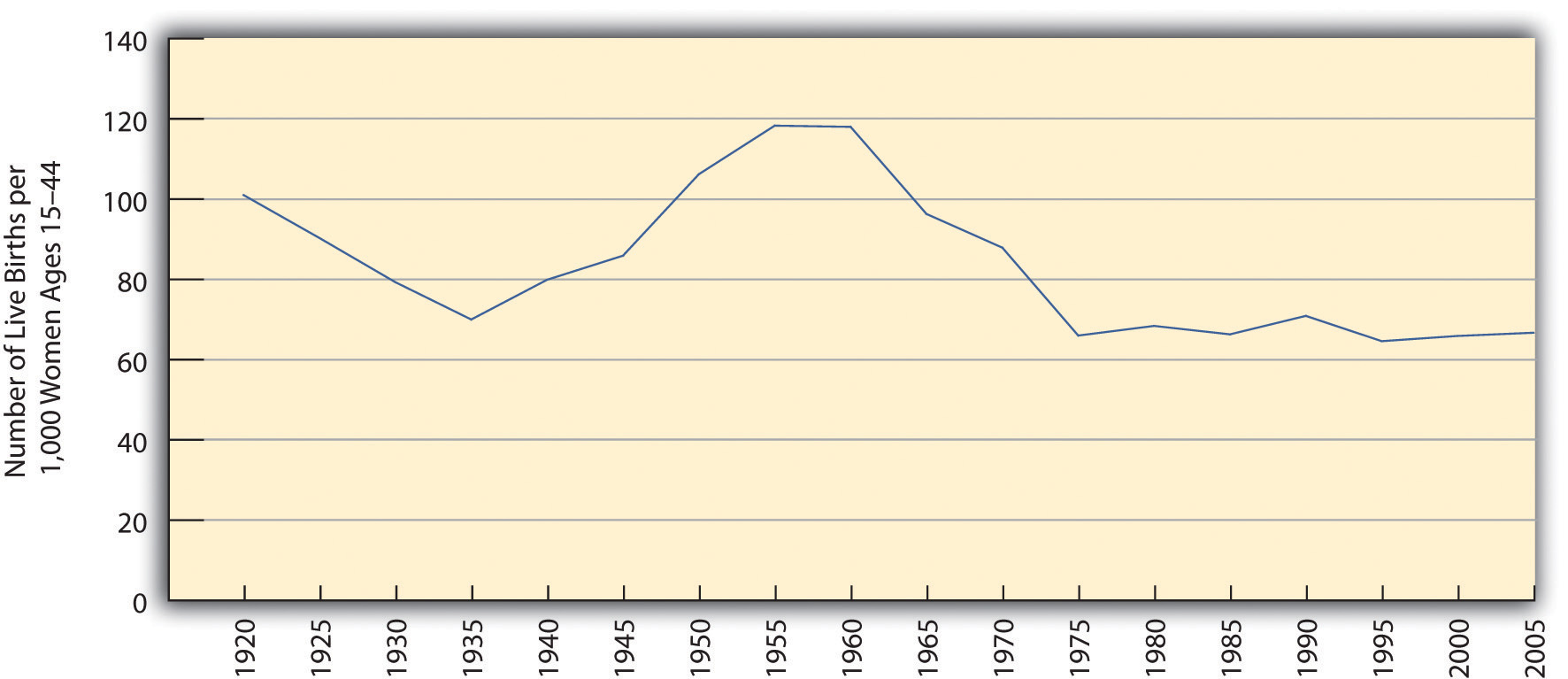
Sources: Data from Martin, J. A., Hamilton, B. E., Sutton, P. D., Ventura, S. J., Menacker, F., Kirmeyer, S., & Mathews, T. J. (2009). Births: Final data for 2006. National Vital Statistics Reports, 57(7), 1–102; U.S. Census Bureau. (1951). Statistical abstract of the United States: 1951. Washington, DC: U.S. Government Printing Office.
The fertility rate varies by race and ethnicity. As Figure 14.6 "Race, Ethnicity, and U.S. Fertility Rates, 2006" shows, it is lowest for non-Latina white women and the highest for Latina women. Along with immigration, the high fertility rate of Latina women has fueled the large growth of the Latino population. Latinos now account for about 16% of the U.S. population, and their proportion is expected to reach more than 30% by 2050 (U.S. Census Bureau, 2010).U.S. Census Bureau. (2010). Statistical abstract of the United States: 2010. Washington, DC: U.S. Government Printing Office. Retrieved from http://www.census.gov/compendia/statab
Figure 14.6 Race, Ethnicity, and U.S. Fertility Rates, 2006
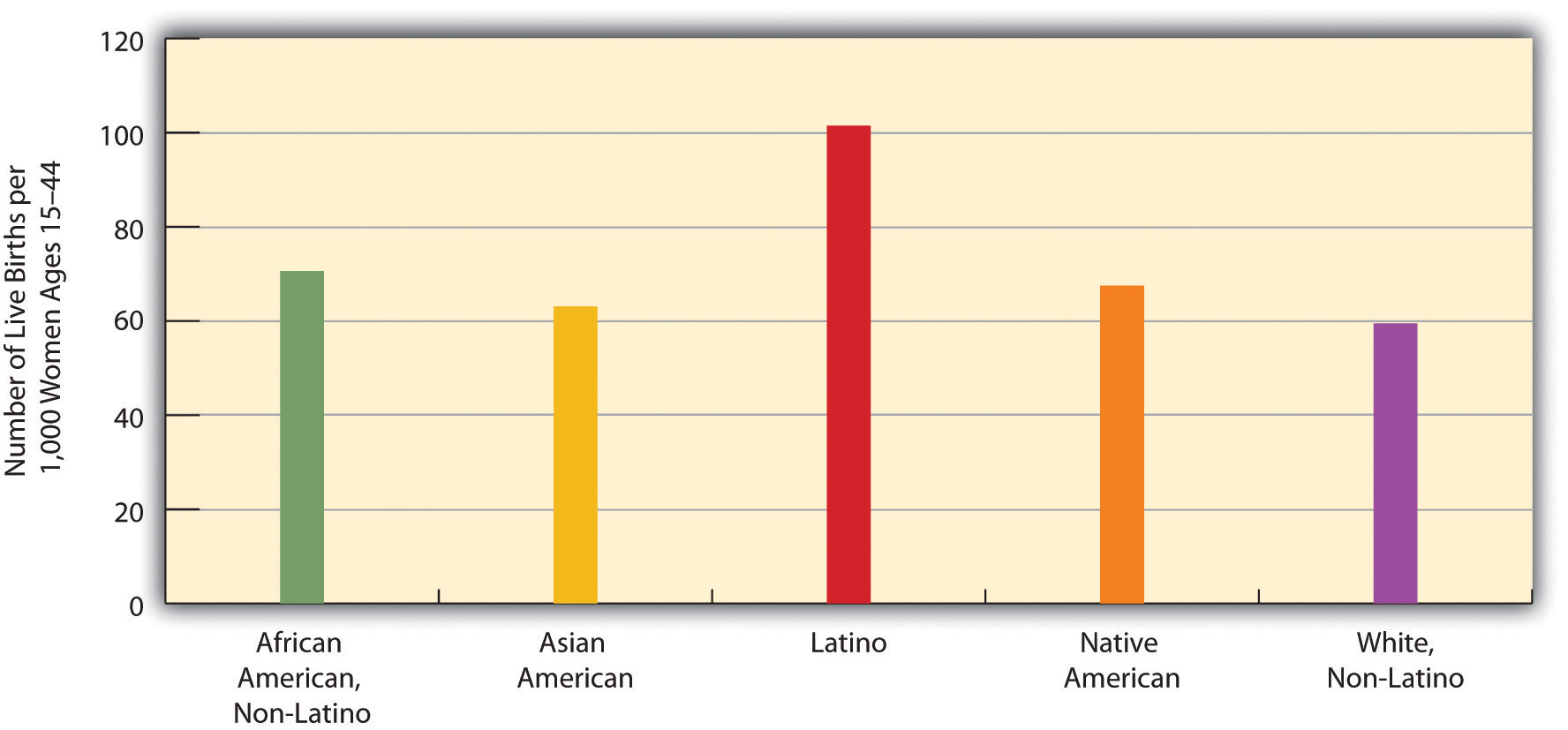
Source: Data from U.S. Census Bureau. (2010). Statistical abstract of the United States: 2010. Washington, DC: U.S. Government Printing Office. Retrieved from http://www.census.gov/compendia/statab.
The fertility rate of teenagers is a special concern because of their age. Although it is still a rate that most people wish were lower, it dropped steadily through the 1990s, before leveling off after 2002 and rising slightly by 2007 (see Figure 14.7 "U.S. Teenage Fertility Rate, 1990–2006"). Although most experts attribute this drop to public education campaigns and increased contraception, the United States still has the highest rate of teenage pregnancy and fertility of any industrial nation (Eckholm, 2009).Eckholm, E. (2009, March 18). ’07 U.S. births break baby boom record. The New York Times, p. A14. Teenage fertility again varies by race and ethnicity, with Latina teenagers having the highest fertility rates and Asian American teenagers the lowest (see Figure 14.8 "Race, Ethnicity, and U.S. Teenage Fertility Rates, 2007").
Figure 14.7 U.S. Teenage Fertility Rate, 1990–2006
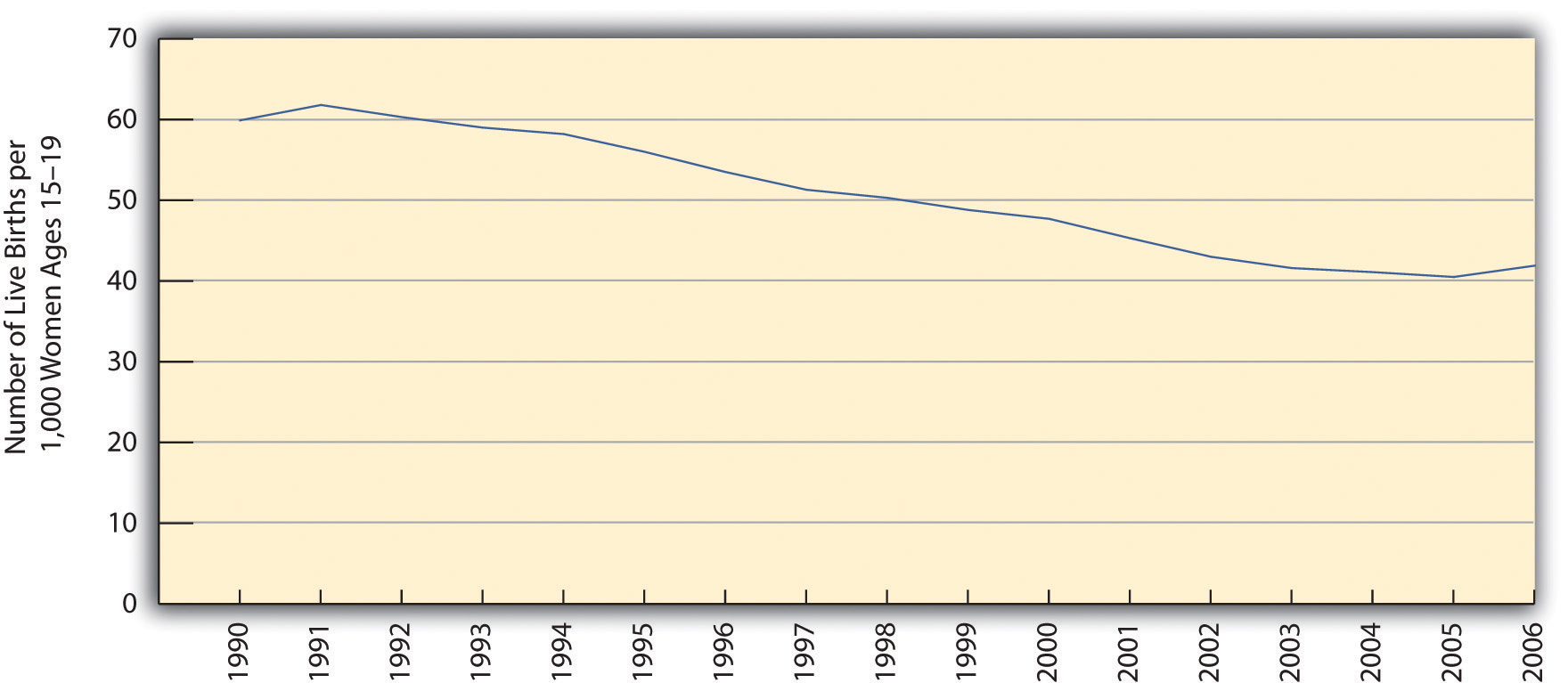
Source: Data from Martin, J. A., Hamilton, B. E., Sutton, P. D., Ventura, S. J., Menacker, F., Kirmeyer, S., & Mathews, T. J. (2009). Births: Final data for 2006. National Vital Statistics Reports, 57(7), 1–102.
Figure 14.8 Race, Ethnicity, and U.S. Teenage Fertility Rates, 2007
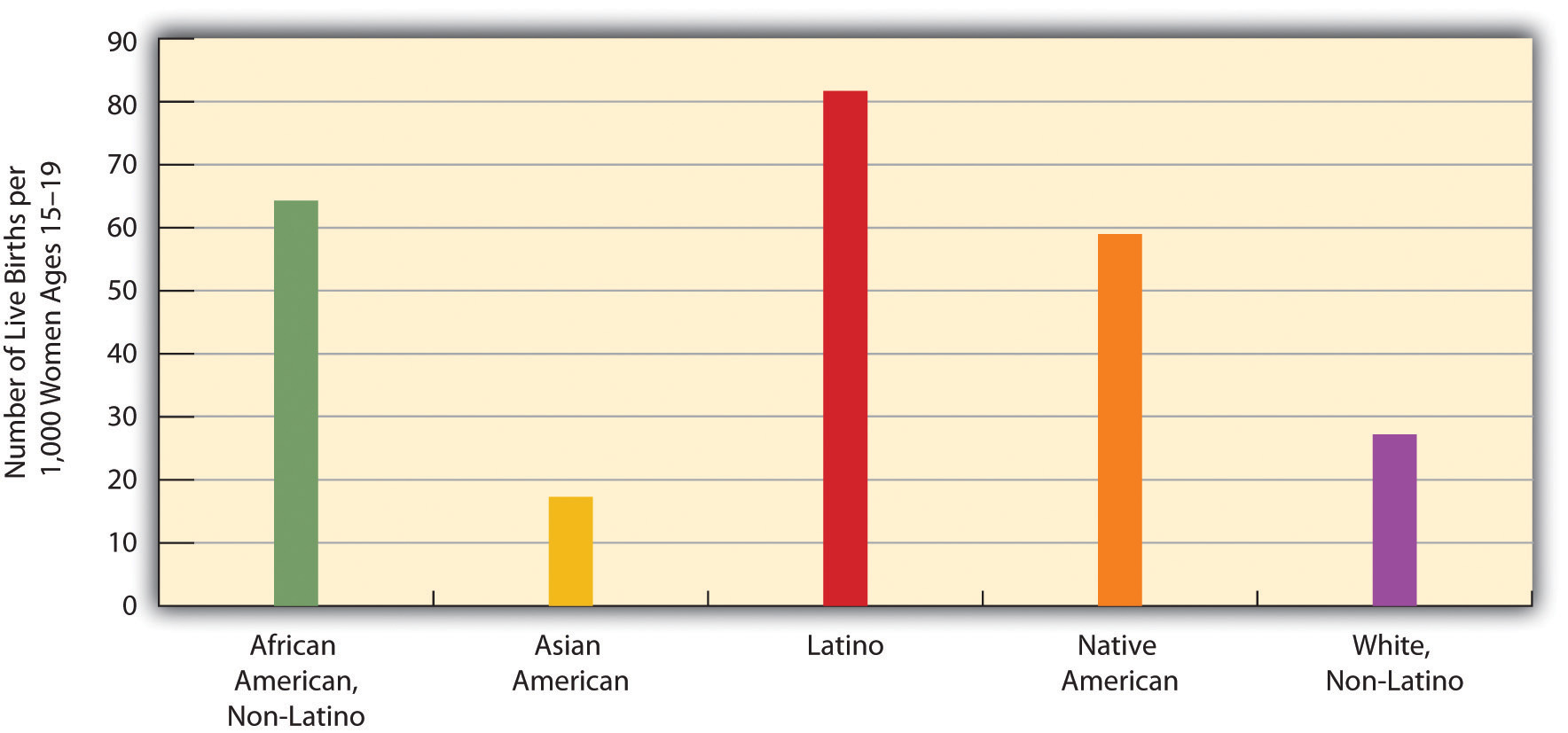
Source: Data from U.S. Census Bureau. (2010). Statistical abstract of the United States: 2010. Washington, DC: U.S. Government Printing Office. Retrieved from http://www.census.gov/compendia/statab.
Fertility rates also differ around the world and are especially high in poor nations (see Figure 14.9 "Crude Birth Rates Around the World, 2008 (Number of Births per 1,000 Population)"). Demographers identify several reasons for these high rates (Weeks, 2008).Weeks, J. R. (2008). Population: An introduction to concepts and issues (10th ed.). Belmont, CA: Wadsworth.
Figure 14.9 Crude Birth Rates Around the World, 2008 (Number of Births per 1,000 Population)
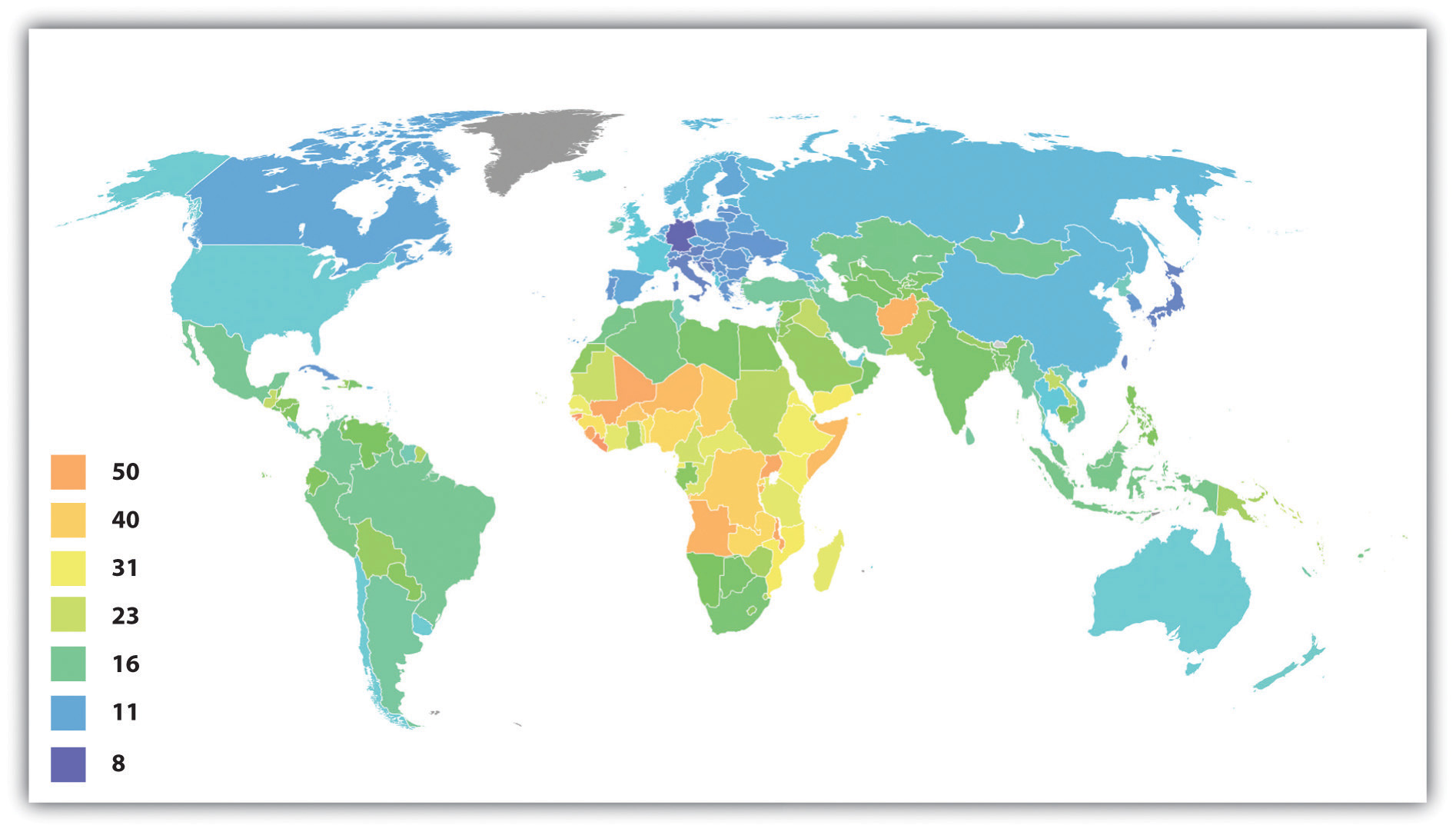
Source: Adapted from http://en.wikipedia.org/wiki/File:Birth_rate_figures_for_countries.PNG.
First, poor nations are usually agricultural ones. In agricultural societies, children are an important economic resource, as a family will be more productive if it has more children. This means that families will ordinarily try to have as many children as possible. Second, infant and child mortality rates are high in these nations. Because parents realize that one or more of their children may die before adulthood, they have more children to “make up” for the anticipated deaths. A third reason is that many parents in low-income nations prefer sons to daughters, and, if a daughter is born, they “try again” for a son. Fourth, traditional gender roles are often very strong in poor nations, and these roles include the belief that women should be wives and mothers above all. With this ideology in place, it is not surprising that women will have several children. Finally, contraception is uncommon in poor nations. Without contraception, many more pregnancies and births obviously occur. For all of these reasons, then, fertility is much higher in poor nations than in rich nations.
Mortality and Death Rates
MortalityThe number of deaths. is the flip side of fertility and refers to the number of deaths. Demographers measure it with the crude death rateThe number of deaths for every 1,000 people in a population in a given year., the number of deaths for every 1,000 people in a population in a given year. To determine the crude death rate, the number of deaths is divided by the population size, and this result is then multiplied by 1,000. In 2006 the United States had slightly more than 2.4 million deaths for a crude death rate of 8.1 deaths for every 1,000 persons. We call this a “crude” death rate because the denominator, population size, consists of the total population and does not take its age distribution into account. All things equal, a society with a higher proportion of older people should have a higher crude death rate. Demographers often calculate age-adjusted death rates that adjust for a population’s age distribution.
Migration
Another demographic concept is migrationThe movement of people into or out of specific regions., the movement of people into and out of specific regions. Since the dawn of human history, people have migrated in search of a better life, and many have been forced to migrate by ethnic conflict or the slave trade.
Several classifications of migration exist. When people move into a region, we call it in-migration, or immigration; when they move out of a region, we call it out-migration, or emigration. The in-migration rate is the number of people moving into a region for every 1,000 people in the region, while the out-migration rate is the number of people moving from the region for every 1,000 people. The difference between the two is the net migration rate (in-migration minus out-migration).
Migration can also be either domestic or international in scope. Domestic migration happens within a country’s national borders, as when retired people from the northeastern United States move to Florida or the Southwest. International migration happens across national borders. When international immigration is heavy, as it has been into the United States and Western Europe in the last few decades, the effect on population growth and other aspects of national life can be significant. Domestic migration can also have a large impact. The great migration of African Americans from the South into northern cities during the first half of the 20th century changed many aspects of those cities’ lives (Berlin, 2010).Berlin, I. (2010). The making of African America: The four great migrations. New York, NY: Viking. Meanwhile, the movement during the past few decades of northerners into the South and Southwest also had quite an impact: the housing market initially exploded, for example, and traffic increased.
Population Growth
Now that you are familiar with some basic demographic concepts, we can discuss population growth in more detail. Three of the factors just discussed determine population growth: fertility (crude birth rate), mortality (crude death rate), and net migration. The natural growth rate is simply the difference between the crude birth rate and the crude death rate. The U.S. natural growth rate is about 0.6% (or 6 per 1,000 people) per year (Rosenberg, 2009).Rosenberg, M. (2009). Population growth rates. Retrieved from http://geography.about.com/od/populationgeography/a/populationgrow.htm When immigration is also taken into account, the total population growth rate has been almost 1.0% per year (Jacobsen & Mather, 2010).Jacobsen, L. A., & Mather, M. (2010). U.S. economic and social trends since 2000. Population Bulletin, 65(1), 1–20.
Figure 14.10 "International Annual Population Growth Rates (%), 2005–2010" depicts the annual population growth rate (including both natural growth and net migration) of all the nations in the world. Note that many African nations are growing by at least 3% per year or more, while most European nations are growing by much less than 1% or are even losing population, as discussed earlier. Overall, the world population is growing by about 80 million people annually.
Figure 14.10 International Annual Population Growth Rates (%), 2005–2010
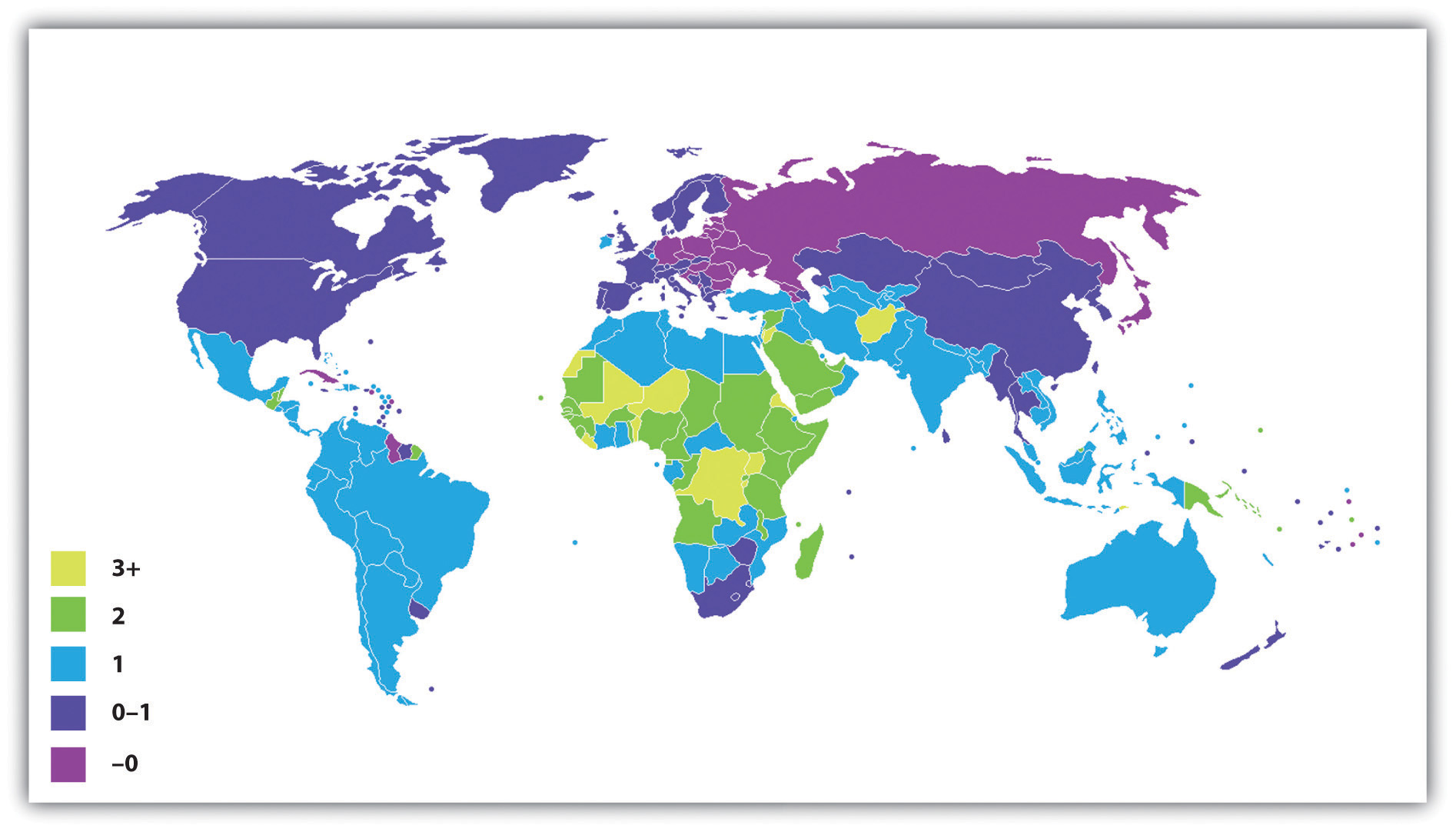
Source: Adapted from http://en.wikipedia.org/wiki/File:Population_growth_rate_world_2005-2010_UN.PNG.
To determine how long it takes for a nation to double its population size, divide the number 70 by its population growth rate. For example, if a nation has an annual growth rate of 3%, it takes about 23.3 years (70 ÷ 3) for that nation’s population size to double. As you can see from the map in Figure 14.10 "International Annual Population Growth Rates (%), 2005–2010", several nations will see their population size double in this time span if their annual growth continues at its present rate. For these nations, population growth will be a serious problem if food and other resources are not adequately distributed.
Demographers use their knowledge of fertility, mortality, and migration trends to make projections about population growth and decline several decades into the future. Coupled with our knowledge of past population sizes, these projections allow us to understand population trends over many generations. One clear pattern emerges from the study of population growth. When a society is small, population growth is slow because there are relatively few adults to procreate. But as the number of people grows over time, so does the number of adults. More and more procreation thus occurs every single generation, and population growth then soars in a virtual explosion.
We saw evidence of this pattern when we looked at world population growth. When agricultural societies developed some 12,000 years ago, only about 8 million people occupied the planet. This number had reached about 300 million about 2,100 years ago, and by the 15th century it was still only about 500 million. It finally reached 1 billion by about 1850 and by 1950, only a century later, had doubled to 2 billion. Just 50 years later it tripled to more than 6.8 billion, and it is projected to reach more than 9 billion by 2050 (U.S. Census Bureau, 2010)U.S. Census Bureau. (2010). Statistical abstract of the United States: 2010. Washington, DC: U.S. Government Printing Office. Retrieved from http://www.census.gov/compendia/statab (see Figure 14.11 "Total World Population, 1950–2050").
Figure 14.11 Total World Population, 1950–2050
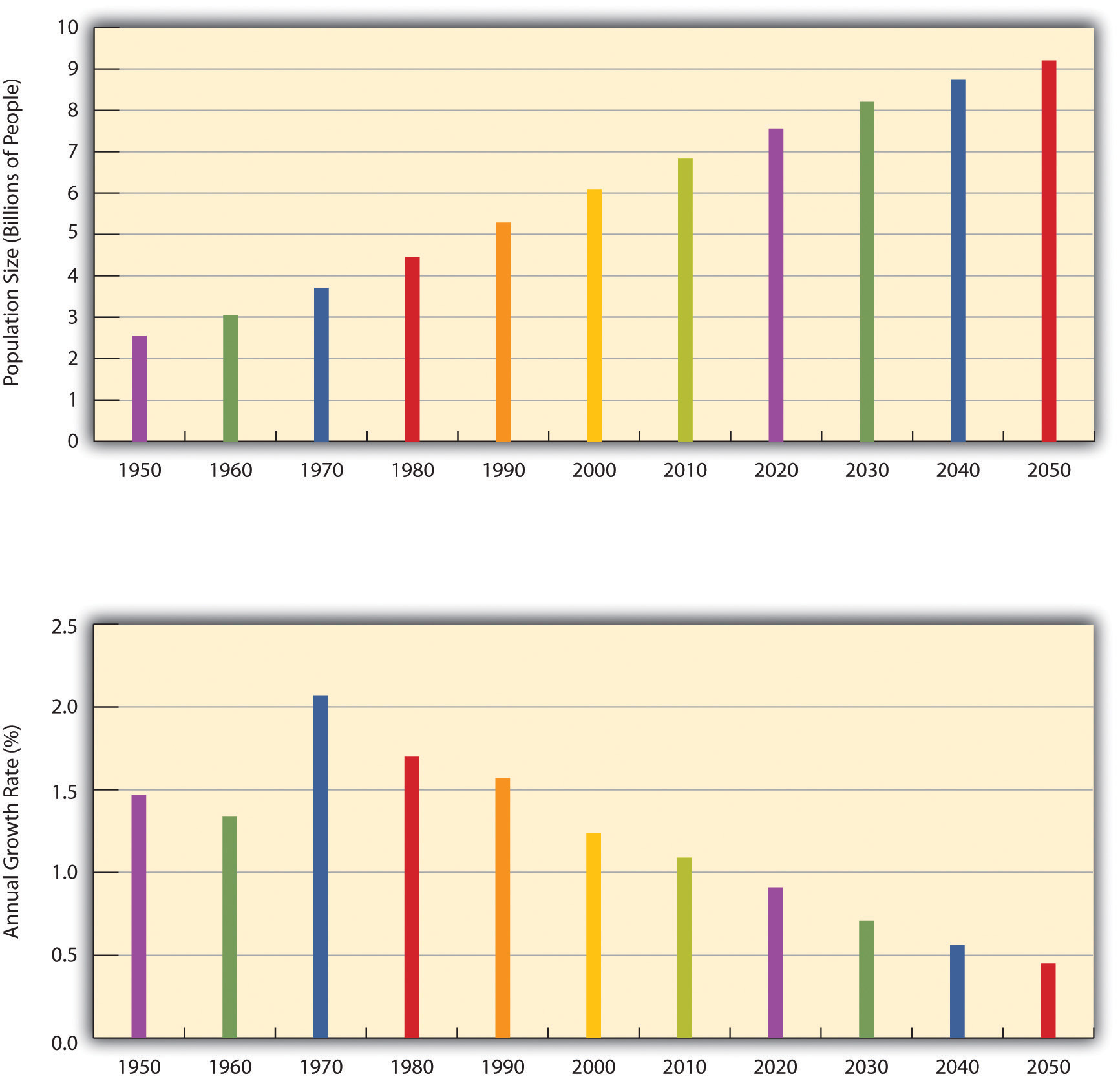
Source: Data from U.S. Census Bureau. (2010). Statistical abstract of the United States: 2010. Washington, DC: U.S. Government Printing Office. Retrieved from http://www.census.gov/compendia/statab.
Eventually, however, population growth begins to level off after exploding, as explained by demographic transition theory, discussed later. We see this in the bottom half of Figure 14.11 "Total World Population, 1950–2050", which shows the average annual growth rate for the world’s population. This rate has declined over the last few decades and is projected to further decline over the next four decades. This means that while the world’s population will continue to grow during the foreseeable future, it will grow by a smaller rate as time goes by. As Figure 14.10 "International Annual Population Growth Rates (%), 2005–2010" suggested, the growth that does occur will be concentrated in the poor nations in Africa and some other parts of the world. Still, even there the average number of children a woman has in her lifetime dropped from six a generation ago to about three today.
Past and projected sizes of the U.S. population appear in Figure 14.12 "Past and Projected Size of the U.S. Population, 1950–2050 (in Millions)". The U.S. population is expected to number about 440 million people by 2050.
Figure 14.12 Past and Projected Size of the U.S. Population, 1950–2050 (in Millions)
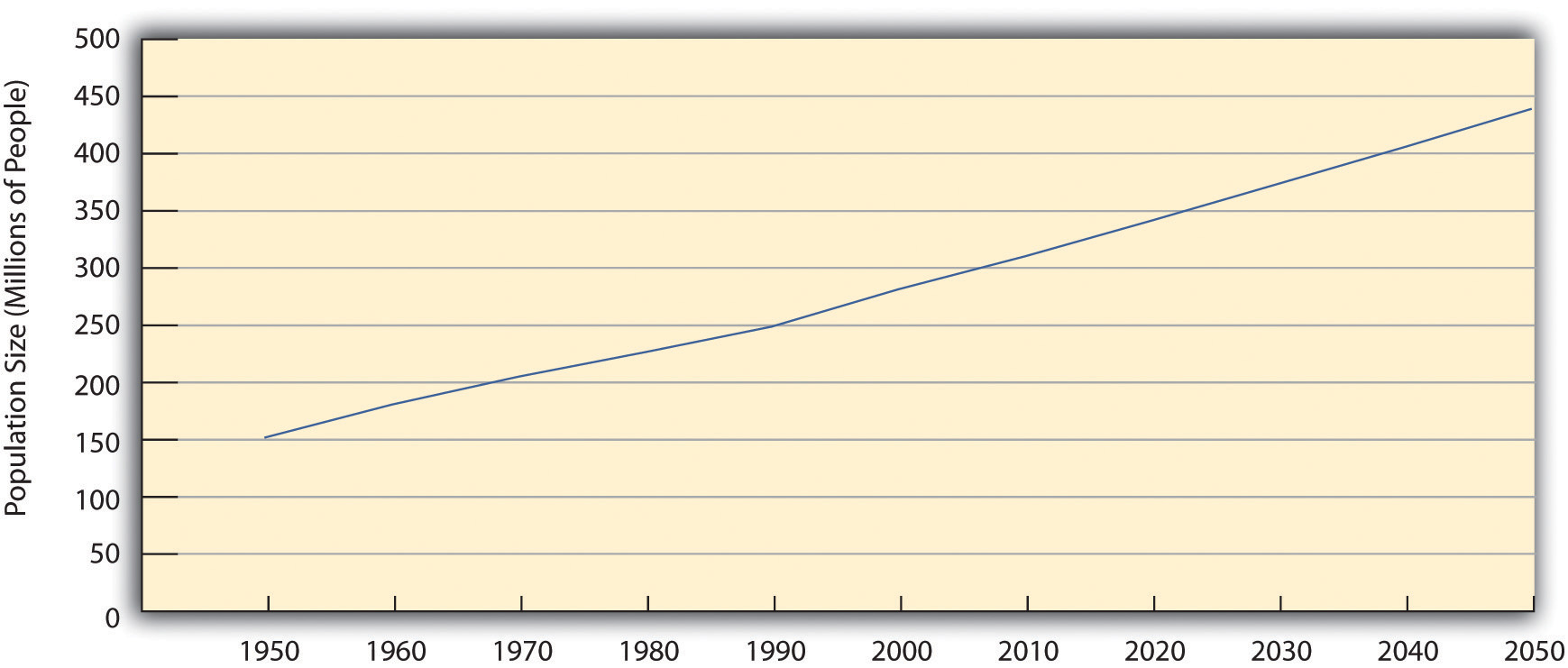
Source: Data from U.S. Census Bureau. (2010). Statistical abstract of the United States: 2010. Washington, DC: U.S. Government Printing Office. Retrieved from http://www.census.gov/compendia/statab.
Views of Population Growth
Earlier we talked about the zero population growth movement and concern about overpopulation that received so much attention a generation ago. Social observers have actually worried about overpopulation since the 18th century.
Figure 14.13

Thomas Malthus, an English economist who lived about 200 years ago, wrote that population increases geometrically while food production increases only arithmetically. These understandings led him to predict mass starvation.
One of the first to warn about population growth was Thomas Malthus (1766–1834), an English economist, who said that population increases geometrically (2, 4, 8, 16, 32, 64, 128, 256, 512, 1024…). If you expand this list of numbers, you will see that they soon become overwhelmingly large in just a few more “generations.” Malthus (1798/1926)Malthus, T. R. (1926). First essay on population. London, England: Macmillan. (Original work published 1798) said that food production increases only arithmetically (1, 2, 3, 4, 5, 6…) and thus could not hope to keep up with the population increase, and he predicted that mass starvation would be the dire result.
Fortunately, Malthus was wrong to some degree. Although population levels have certainly soared, the projections in Figure 14.11 "Total World Population, 1950–2050" show that the rate of increase is slowing. Among other factors, the development of more effective contraception, especially the birth control pill, has limited population growth in the industrial world and, increasingly, in poorer nations. Food production has also increased by a much greater amount than Malthus predicted, although, as noted earlier, hunger remains a serious problem in poor nations because of inequalities in food distribution.
Demographic Transition Theory
Other factors also explain why population growth has not risen at the geometric rate that Malthus predicted and is even slowing. The view explaining the interaction of these factors is called demographic transition theoryA theory that links population growth to the level of technological development across three stages of social evolution. (Weeks, 2008),Weeks, J. R. (2008). Population: An introduction to concepts and issues (10th ed.). Belmont, CA: Wadsworth. mentioned earlier. This theory links population growth to the level of technological development across three stages of social evolution. In the first stage, coinciding with preindustrial societies, the birth rate and death rate are both high. The birth rate is high because of the lack of contraception and the several other reasons cited earlier for high fertility rates, and the death rate is high because of disease, poor nutrition, lack of modern medicine, and other problems. These two high rates cancel each other out, and little population growth occurs.
In the second stage, coinciding with the development of industrial societies, the birth rate remains fairly high, owing to the lack of contraception and a continuing belief in the value of large families, but the death rate drops because of several factors, including increased food production, better sanitation, and improved medicine. Because the birth rate remains high but the death rate drops, population growth takes off dramatically.
In the third stage, the death rate remains low, but the birth rate finally drops as families begin to realize that large numbers of children in an industrial economy are more of a burden than an asset. Another reason for the drop is the availability of effective contraception. As a result, population growth slows, and, as we saw earlier, it has become quite low or even gone into a decline in several industrial nations.
Demographic transition theory gives us reason to be cautiously optimistic regarding the threat of overpopulation. As poor nations continue to modernize—much as industrial nations did 200 years ago—their population growth rates should start to decline. Still, population growth rates in poor nations continue to be high, and, as the “Sociology Making a Difference” box discussed, inequalities in food distribution allow rampant hunger to persist. Hundreds of thousands of women die in poor nations each year during pregnancy and childbirth. Reduced fertility would save their lives, in part because their bodies would be healthier if their pregnancies were spaced farther apart (Schultz, 2008).Schultz, T. P. (2008). Population policies, fertility, women’s human capital, and child quality. In T. P. Schultz & J. Strauss (Eds.), Handbook of development economics (Vol. 4, pp. 3249–3303). Amsterdam, Netherlands: North-Holland, Elsevier. Although world population growth is slowing, then, it is still growing too rapidly in much of the developing and least developed worlds. To reduce it further, more extensive family-planning programs are needed, as is economic development in general.
Key Takeaways
- Concern over population growth has declined for at least three reasons. First, there is increasing recognition that the world has an adequate supply of food. Second, people of color have charged that attempts to limit population growth were aimed at their own populations. Third, several European countries have actually experienced population decline.
- To understand changes in the size and composition of population, demographers use several concepts, including fertility and birth rates, mortality and death rates, and migration.
- Demographic transition theory links population growth to the level of technological development across three stages of social evolution. In preindustrial societies, there is little population growth; in industrial societies, population growth is high; and in later stages of industrial societies, population growth slows.
For Your Review
- Before you read this chapter, did you think that food scarcity was the major reason for world hunger today? Why do you think a belief in food scarcity is so common among Americans?
- The text states that the average woman must have 2.1 children for a society to avoid population decline. Some women wish to have no children, some desire one or two children, and some prefer to have at least three children. What do you think is the ideal number of children for a woman to have? Explain your answer.




